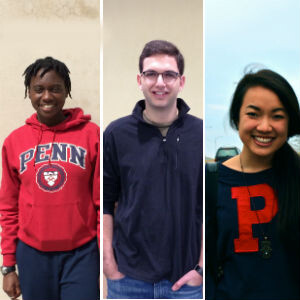Penn Students Explore Civil Rights Movement Sites
A unique spring break trip for some University of Pennsylvania students could turn a vacation into a vocation.
Students from the Greenfield Intercultural Center’s Alliance and Understanding Program at Penn traveled to four southern cities where some of the most significant civil rights movement events occurred.
The group of 18 students from Penn was led by Valerie DeCruz of the Greenfield Intercultural Center, Rob Carter of the African American Resource Center and Ira Blum of Penn Hillel. They also visited the Civil Rights Memorial in Montgomery, Ala., which honors 40 people who were killed fighting for equal rights. They also visited the Dexter Avenue King Memorial Baptist Church, where Martin Luther King Jr. was the pastor for six years.
They walked over the Edmund Pettus Bridge in Selma, Ala., the site where armed police officers attacked civil rights demonstrators on March 7, 1965.
“I’ve read about it in books, but it doesn’t become real until you’re actually standing there and thinking about the men and women who were marching on that very bridge,” says Samantha Osaki, a senior urban studies and English major from Walnut, Calif. “It made me realize again how important it is to vote and to get your voice out because so many people had to fight to make that happen.”
The journey was the culmination of a two-month, non-credit program that’s collaboration between the GIC, the African American Resource Center and Penn Hillel. The program focused on the partnership between black and Jewish communities during the movement.
At Penn, the students studied and attended lectures about the fight for civil rights, but the trip gave them a deeper understanding of what happened and about the state of race relations today.
On the trip, they heard from religious and community leaders about how Jews joined forces with blacks to combat racial injustices.
“The relationship makes a lot of sense in a lot of regards,” says Matt Kalmans, a junior political science major from Weston, Conn. “There’s a shared history of oppression and injustice.”
Shakele Seaton, a junior majoring in English, with a concentration in African American studies, was surprised to hear about the alliances between Jews and blacks. Growing up in Brooklyn, the contacts between blacks and Jews in her neighborhood could be tense or even violent.
“Knowing that we have that shared history,” Seaton says, “we could all grow so much from that and work together so much more to eliminate that tension.”
The Jewish leaders who met with the students in the South shared with the group that while some Jews there didn’t join forces with black civil rights leaders for fear of facing reprisals, many others did.
Kalmans says, “I was heartened to know that the leaders of the Jewish community from that area and all over the country traveled to these marches to stand with the civil rights leaders because they didn’t forget what it was like to be the object of oppression.”
During a tour of a synagogue in Birmingham, Ala., the rabbi shared a story with the group about ways in which blacks and Jews are allies today.
Documenting the visit in her blog, Osaki wrote:
“She [the rabbi] told us that when the temple was being renovated over the course of a year, its members needed an alternative place of worship. A pastor extended an open invitation to the rabbi of the temple, offering to share South Street Baptist Church’s facilities. What’s more, when the Jewish congregation walked the Torah to that Christian place of worship, its members were welcomed by a sign that read, ‘My house shall be a house of prayer for all.’”
Later, at a meeting with the Rev. Bob Graetz and his wife, Jean, who despite safety threats to them and their children, continued to help fight racial injustices in the South.
In Seaton’s trip blog, she wrote about the Graetz’s courage:
“This man literally walked side-by-side with Dr. Martin Luther King Jr. in his faith, prepared to die for what's right. What was amazing is their sturdy faith in God. This faith was in them as they marched, as they received threats, as their children's lives hung in the balance, and they trusted God all along the way.”
The six-day trip was packed with visits to historical sites, talks and meetings with civil rights leaders. The group had the opportunity to hear a speech by Julian Bond, who spoke about how the United States still has work to do to improve race relations.
At the end of each day the group gathered to share their thoughts on what they what they had seen and heard. Many wondered if they could be as courageous as the participants of the movement.
“It’s something we had to come to grips with during the trip,” Kalmans says. “Whether we could have done that ourselves, and what sort of person it takes to put your own safety and self interests aside and stand up for what you know to be morally right.”
During the trip many of the students felt a call to public service.
Some students were inspired after visiting the Equal Justice Initiative in Montgomery to consider a summer internship with the firm or a similar group. The organization provides legal representation to indigent defendants and prisoners who are treated unjustly.
Seaton has known that she wants to pursue a career in social justice and civil rights and now wonders if it’s possible for her to help make a difference in her hometown.
“I’m not sure how I can bring that back to Brooklyn to effect change,” Seaton says. “I know it starts with education.”








